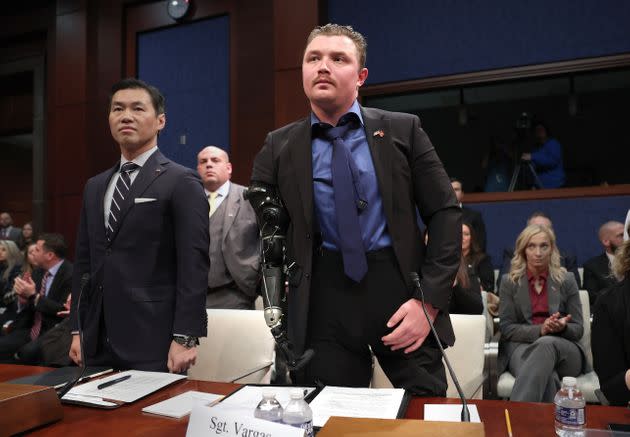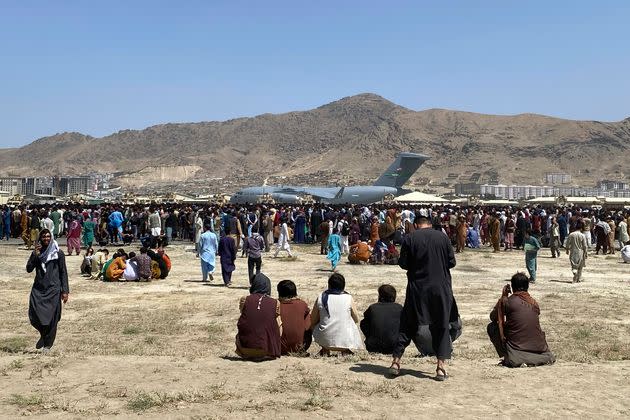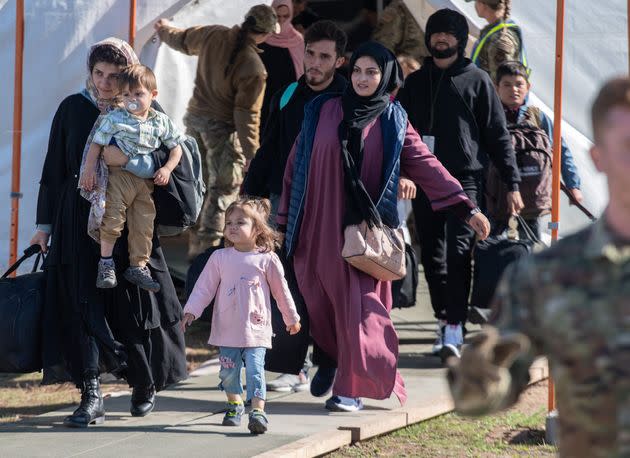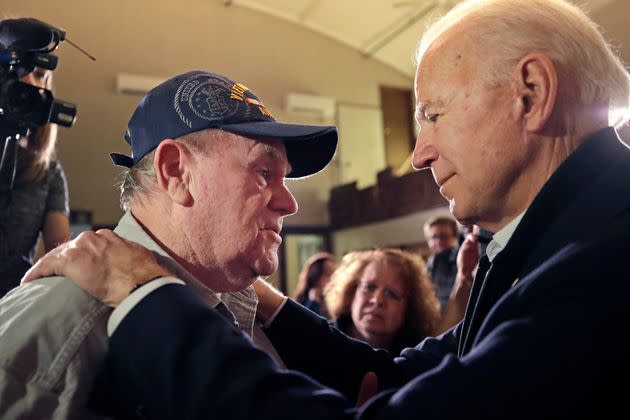‘Still Hurting’: Vets, Volunteers Are Appalled By Biden’s Memo On Afghanistan Withdrawal
- Oops!Something went wrong.Please try again later.
- Oops!Something went wrong.Please try again later.
President Joe Biden recently offered a new defense of his controversial 2021 withdrawal from Afghanistan ― in an unsigned 12-page memo that the White House released amid religious holidays with little warning to U.S. officials or reporters.
Two weeks later, officials, veterans and volunteers who worked on the mission are still deeply frustrated, saying that Biden’s narrative about Afghanistan is too focused on political point-scoring and that the administration should do more to tackle the ongoing crisis.
“It felt like an eighth grader wrote it from the middle school cafeteria. I think the public deserved more of an answer,” said a current service member who spent months helping evacuees from Afghanistan and called the document “petty.”
“There’s a big portion of America that’s still hurting about this. There are still people who are trying to get people out. There’s still so much work going on that [Washington] has forgotten about,” added the service member, who spoke on the condition of anonymity for fear of professional retaliation.
The White House statement is an unclassified summary of an “after-action review” that Biden directed across government agencies involved in the Afghan pull-out. The memo largely addresses how much responsibility Biden should bear for the way America ended its 20-year mission in Afghanistan — with a two-week withdrawal in which 13 American service members and hundreds of Afghan civilians died and thousands of people eligible for U.S. evacuations were left behind.
The answer, according to the memo: not much. Before Biden withdrew U.S. forces from Afghanistan in August 2021 and Taliban militants took over the country, the administration carried out “deliberate, intensive, rigorous, and inclusive” planning, the statement argues, including preparing for a major evacuation starting in May 2021.
Instead of evaluating the Biden administration’s internal debates and choices, the White House statement places significant blame on former President Donald Trump, noting that he signed a deal with the Taliban that set a deadline for U.S. forces to leave Afghanistan. Trump left no plan for a withdrawal or evacuation and damaged key national security institutions that had to implement the pull-out, according to the memo. Additionally, the memo raises questions about U.S. intelligence and military commanders, as well as Afghans themselves, saying Biden had little warning of a rapid Taliban takeover, let military personnel determine the operational details of the evacuation and tried without success to urge a stronger Afghan resistance to the Taliban.
Nine people who worked on the withdrawal and evacuation mission told HuffPost the White House statement offers a dishonest view of the situation. By emphasizing Trump’s decisions, overlooking gaps in Biden’s preparation and casting a shambolic moment as a success, the White House is fueling fresh frustration and hurting its credibility on Afghanistan even further, they argued.
Critics say Biden’s team should acknowledge its mistakes and identify who made decisions that damaged the rescue effort, as well as address the trauma and humanitarian toll that their approach caused. Veterans and other volunteers who have spent years trying to save Afghan partners of the U.S. also want Biden to take immediate steps to make ongoing evacuation efforts easier.
“From a military perspective and from even a citizen’s perspective it’s very difficult to believe in the [memo]... to believe in our country and to believe that I did the right thing in my youth,” said Perry Blackburn, a retired lieutenant colonel who was one of the first soldiers to deploy to Afghanistan in 2001. The founder of a nonprofit called AFGFree that works on evacuation missions and aid, Blackburn wants Biden to change administrative policies to make it easier for vulnerable Afghans to resettle abroad.
The administration is “tired” of the issue, he said, adding: “We’re relentless, and they want to move on.”
The memo and the resulting outrage come amid growing scrutiny of the withdrawal.
Republicans are using their control of the House of Representatives to pressure the Biden administration to release more information on its Afghan strategy and to hold high-profile hearings on the matter. Last month, the first hearing featured testimony from Sgt. Tyler Vargas-Andrews, who was severely wounded in the Aug. 26, 2021, terrorist attack on Kabul airport. He accused Biden of “an inexcusable lack of accountability and negligence.”

Marine Corps Sgt. Tyler Vargas-Andrews was one of multiple U.S. service members wounded during a suicide attack on the American evacuation mission in Kabul, Afghanistan, in August 2021.
Scott Mann, a veteran who runs an Afghan rescue effort called Task Force Pineapple, also testified at the March hearing. In a LinkedIn post about this month’s White House memo, he said the document showed “a tremendous amount of bias and almost deluded thinking.”
“It does not reflect, in my assessment, good institutional leadership, the kind of leadership that we were taught as young leaders and junior officers,” Mann added. “Certainly the Trump administration bears a tremendous amount of responsibility… but the withdrawal ― and, worse, the abandonment of our allies ― falls squarely on this administration.”
Contacted for comment, a White House spokesman noted that the administration helped a significant number of Afghans. “While no one, including our intelligence community, anticipated that the Afghan government would fall as quickly as it did, we were able to conduct one of the largest airlifts in history — a massive undertaking that would not have been possible without significant contingency planning,” the spokesman wrote in an email.
The next majorAfghanistan hearing is scheduled for Wednesday. It will feature testimony from the inspectors general of the Pentagon, the State Department and the U.S. Agency for International Development, as well as the congressionally appointed special inspector general for Afghan reconstruction ― four watchdogs with access to sensitive and potentially embarrassing materials about the administration’s Afghan policy.
‘A Different Kind Of Trauma’
Taliban forces captured Afghanistan’s capital of Kabul on Aug. 15, 2021. Between then and Aug. 31, more than 120,000 Americans, other foreigners and Afghans fled on frantically arranged flights that left Kabul airport as 6,000 U.S. troops and local partners guarded the facility. Tens of thousands of people tried to get to the airport, often with help from contacts abroad, such as U.S. military personnel and veterans, nonprofit groups and Afghan expatriates. Many of them, including Afghans who would likely face Taliban persecution for working with the U.S. and nearly 1,000 American citizens, were unable to board planes.
On Aug. 26, a suicide bombing attack at one of the gates to the airport killed 13 U.S. troops and at least 170 Afghans, and wounded scores of others. Three days later, the U.S. launched a drone strike that officials said was meant to stop another attack at the airport. The strike instead killed 10 civilians, including seven children, The New York Times revealed.
By the time the airlift ended, desperate Afghans and foreigners who remained in the country had few chances to leave. Meanwhile, American officials and volunteers were struggling to care for the tens of thousands of people who were evacuated.
Eighteen months later, the work has yet to end.
Many volunteers are still spending time and personal resources to help people escape Taliban rule and build new lives. That work can weigh heavy: Multiple people told HuffPost that becoming involved in the effort activated their and their colleagues’ post-traumatic stress from military service and left scars on their families.
“Just in the last six weeks, we have had another divorce and another bankruptcy come in,” said Ben Owen, who runs a veterans’ group called Flanders Fields. Some veterans who became involved in the Afghan effort and had previously struggled with substance abuse ended up relapsing, he added.
The active service member, who worked with the nearly 35,000 Afghans who passed through Ramstein Air Base in Germany, told HuffPost she “really struggled in the months after [the evacuation] because we just held it together for so many months.”
“It was a different kind of trauma or post-traumatic stress than combat in so many ways: You took on a lot on behalf of other people,” she added, citing examples like caring for children who came to the facility without their parents.
The rushed, ad-hoc nature of the withdrawal and evacuation made such consequences inevitable, people involved believe, as officials and volunteers took on herculean tasks beyond their skill sets, stretched themselves to offer logistical and emotional support to terrified contacts on the ground and juggled new responsibilities with their existing jobs and personal lives.
The Biden administration failed to suitably prepare or heed warnings, two current and two former officials told HuffPost, disputing the claims of intense planning in the recent memo.
“I was sitting in [White House] meetings as late as June and July, and nobody was acting as though this was an urgent thing we needed to start making decisions on,” said a former national security official who requested anonymity to avoid retaliation.
A current Biden administration official recalled meeting with a high-ranking active-duty officer at CENTCOM, the Pentagon command that oversaw Afghanistan operations, in mid-July 2021. “Is anyone reading the emails we’re sending?” he asked her. “Do you feel like Washington gets it? We need help. We’re not qualified to help refugees ― and, by the way, this is going to be really bad.”
“I thought to myself: ‘Nobody is reading your emails,’” said the official, who was not authorized to speak on the record. She noted that much of the Biden administration was still working from home and away from secure government facilities at the time because of the pandemic.
Biden’s aides had more than a year to craft a strategy, noted Marla Keenan, a civilian protection expert who volunteers with an Afghan evacuation group, because Trump had announced his deal with the Taliban well before the 2020 election.
“As soon as Trump said they were going to withdraw, the planning should have started ― it was fairly obvious there was going to be a problem,” Keenan said. “There were challenges that were inherited, but I do not believe they couldn’t have been overcome.”
A White House spokesman presented with these arguments told HuffPost the administration spent months getting ready to leave Afghanistan. “There was extensive planning underway to prepare for all contingencies as early as March 2021,” the spokesman wrote in an email. “This planning continued rigorously for months.”
And at a press conference after the memo’s release, White House national security spokesman John Kirby argued: “Decisions made and the lack of planning done by the previous administration significantly limited options available to [Biden].”
“The president’s transition team asked to see plans for [troop] removal. They asked to see plans for a security transition to the Afghan government. And they asked to see plans to increase the processing of Special Immigrant Visas. None were forthcoming,” Kirby continued. “Transitions matter. That’s the first lesson learned here. And the incoming administration wasn’t afforded much of one.”
Once the evacuation began, a then-State Department official said the “extremely unorganized” process left staff at the agency ― who were handling critical tasks like rushed visa processing and liaising with foreign governments that agreed to host Afghans ― openly crying at work.
“The morale hit a critical low where both appointees and civil servants were ashamed,” the former official said, speaking on the condition of maintaining anonymity.
Amid worrying reports from the ground, conflicting instructions from superiors and rigid procedures that were not suitable for an emergency, “there was no playbook … the official side didn’t know what to do,” said the current official. She and many other U.S. officials became involved with nongovernmental efforts to save vulnerable Afghans, U.S. citizens and others. “No one was telling me to stop; everybody was saying, ‘Keep doing what you’re doing,’” she said.

Thousands of people tried to access the U.S. airlift out of Kabul airport in August 2021. Many of those eligible for evacuation were not able to get on planes.
Volunteers and officials scrambled to design their own procedures, conscious that they were dealing with matters of life and death.
“They were going to leave behind the very people that bought into the same thing I did, and those people were going to be hunted by the very enemy I fought,” said Blackburn, the retired Green Beret. “I don’t think the government anticipated us to organize so quickly and begin to advocate for these folks and be as relentless as we have been.”
Determined as they were, veteran volunteers had to contend with limited information, a ticking clock and security threats.
“With zero information or knowledge beforehand, we’re suddenly having to realize that it’s not just civilian volunteers or active-duty troops or contractors [at the airport] ― we have to navigate three rings of security, one of which is the Taliban,” Owen said.
For vulnerable Afghans, the irregular process meant unreliable access to help, noted Alex McCoy, a veteran and activist.
“There was a perception that high-ranking powerful people were able to get their folks out and regular people were not able to: Out of the blue, some billionaire would say, ‘Here’s the information for someone I once met in Geneva.’ People were calling [Transportation Secretary and military veteran Pete] Buttigieg and generals,” McCoy said. “Every inequity that exists got amplified in the absence of an intentionally designed process.”
And getting out of Afghanistan was no guarantee of stability.
Personnel who were working at facilities receiving evacuee flights, like the Ramstein base in Germany, were never certain who back in the U.S. was directing the evacuation and resettlement operation, the service member said. “We had to take it upon ourselves to take charge. … We were like, ‘This is an airlift base ― we don’t know how to run a city of evacuees!’”
“The head that needs to roll is whoever didn’t put somebody in charge,” she added.
The former national security official challenged the White House memo’s claim that Trump-era dips in personnel at agencies like the State Department drove the pandemonium. “They had an entire task force, they plussed-up everybody… it wasn’t a matter of not having enough bodies,” said the former official. “It was that we had people who were operating from this position of inexperience in crisis management, risk aversion and a lack of interagency cooperation.”
Some administration officials working on the operation came to believe that national security adviser Jake Sullivan or Secretary of State Antony Blinken would be fired over the chaos, the one current and two former officials said.
“There weren’t any practitioners in Biden’s Cabinet ― in this situation where you need an absurd level of practicality, all you have is bureaucrats and theorists,” said the current official. She was specifically critical of Sullivan, saying: “Jake Sullivan has never had to make a lifesaving decision. He has been paid to answer questions in an intelligent way. What in Jake Sullivan’s résumé qualified him to make lifesaving decisions? They need to think about how that appears when you’ve got someone up there floundering and not being held accountable.”
A White House spokesman declined to address the criticism of Sullivan or critiques of how the administration handled personnel working on the evacuation.
At Ramstein, the service member relied on her previous years of experience in Afghanistan to reduce the risk of violence in the crowded camps ― where emotions ran high as it remained unclear when people would be allowed to leave ― and to help staff be culturally sensitive. She tracked the danger of inter-ethnic and inter-tribal conflict, monitored whether evacuees who previously held top government posts were being overly dominant, communicated with Afghans in the U.S. who had family or contacts in the camp and designed lessons to help people prepare for life in America.
“It was better because we made it better,” she said. “Help was not on the way.”

Thousands of Afghans spent more than a month at Ramstein Air Base in Germany, where one U.S. service member said officials were unsure who was overseeing the resettlement process.
By Oct. 30, the Ramstein mission ended: U.S. forces completed the process of taking evacuees there to the United States.
But government support for the personnel involved there and at other facilities has been inconsistent, the service member said. Troops permanently stationed at the bases received “decompression time” while those who were deployed there temporarily only received assistance or leave if they personally requested it or their specific unit provided it.
“You had young officers, young State Department folks just in charge… and once it was done, in a sense it was like [the government] didn’t give a shit anymore,” the service member added.
For veterans who were affected by the Biden administration’s policy, a post-withdrawal surge in Veterans Affairs Department outreach helped, multiple veterans said. But the botched mission and the seeming U.S. failure could resonate painfully for years. The former national security official, who is herself a veteran, said she worries that research will eventually link the situation to an uptick in post-traumatic stress claims and veteran suicides.
People who are still involved in evacuation efforts are alarmed about waning interest and resources despite Afghanistan’s worsening condition. Moments like the release of Biden’s defensive memo shift public attention to partisan jousting, and there is deepening distrust between volunteers and the administration, despite the White House memo’s assertion that the administration saw outside support as “critical” and it is “building on these partnerships.”
“We’re still in the thick of it ― it should be focused on action, not ‘protect your ass’ yet,” Keenan said. She said she hopes the veterans she is assisting will eventually help evacuate Afghan journalists, activists, artists and others at risk from the Taliban.
“It’s not just those who helped the U.S. military or NATO. It was also a lot of other people who bought into what we were selling,” Keenan said.
Playing Politics
The Biden administration has always been extremely sensitive about political embarrassment over its Afghanistan policy. Still, Biden’s team misjudged how its policies would upset specific groups with influence over the national conversation on foreign policy, like veterans who are deeply invested in the U.S. commitment to foreign partners, argued McCoy, the veteran and activist who lobbied to end the U.S. mission in Afghanistan.
“The goodwill that was created by the decision to withdraw was harmed by the decision to not evacuate” Afghans with U.S. links sooner, McCoy said.
He noted that the administration often justifies its approach by giving Biden credit for ending a war that three of his predecessors failed to conclude. “President Biden refused to send another generation of Americans to fight a war that should have ended for the United States long ago… there was no scenario— except a permanent and significantly expanded U.S. military presence — that would have changed the trajectory,” the recent White House memo states.
But some of the loudest voices for pulling out American troops, including prominent veterans’ and human rights groups, repeatedly said they wanted to see both a withdrawal and an evacuation of Afghans who were tied to the U.S. or facing danger from the Taliban. And the Biden team’s boasts of “ending forever wars” may disturb people whose careers were defined by the Afghanistan mission and other post-9/11 conflicts, said the current administration official: “This is not the language we want to be using when we’re trying to connect to veterans.”
Biden’s team repeatedly seeks “to conflate the decision to withdraw and the consequences of deciding not to do the evacuation sooner,” McCoy said. He said he believes that framing upsets people disappointed in the evacuation and boosts hawks who never wanted a withdrawal at all, including top Republicans.

President Joe Biden with a Vietnam War veteran on the 2020 campaign trail. As a presidential candidate, he pledged to wind down America's involvement in overseas conflicts.
Arguably, the administration’s own political caution about offering refuge helped create the negative perception of the withdrawal that Biden is still struggling to combat.
For instance, the administration rejected ideas from activist groups and lawmakers from both parties, such as rapidly sending vulnerable Afghans to Guam for processing before relocating them stateside, seemingly because Biden was antsy about appearing to spark mass migration or risk national security.
“The memo does not mention that months were wasted looking for third countries to host evacuees because of the unwillingness to evacuate them to the logical place: the U.S.,” McCoy said.
The roll-out of the memo reflected how the administration is still misjudging the potential risks of its choices. By dispatching Kirby, a retired admiral who now works in the White House, to talk to journalists about the memo, Biden’s team may have hoped that his military background would bolster the administration’s argument. Instead, Kirby’s comments were especially jarring for many onlookers with military ties.
“For all this talk of chaos, I didn’t see it from my perch,” said Kirby, who was the Pentagon spokesperson at the time of the withdrawal.
Owen called Kirby’s remark “unconscionable,” and the current service member commented: “Thirteen young American service members are dead ― that’s not the right words to use.”
“Hearing Kirby in my mind absolutely lie about what happened 18 months ago in Afghanistan and then double down with [this memo], it is difficult for me to understand how we’re ever going to get better at what we do,” Blackburn said. “Kirby says there was no chaos ― there were people hanging off of an airplane, brother!”
A White House spokesman declined to address the pushback to Kirby’s remarks.
Asked where they would like Biden’s team to focus its energy, veterans and volunteers shared a wishlist of changes. Blackburn hopes the president will drop the requirement for Afghans seeking visas to have in-person interviews, which requires them to somehow leave Afghanistan to get to a U.S. embassy and to be able to schedule an embassy appointment amid a staggering global backlog. Additionally, he wants the U.S. to push other countries to take in Afghan refugees.
Owen said he believes Congress is getting closer to passing the Afghan Adjustment Act, which would provide a path to permanent residence for Afghans evacuated to the U.S.
Nearly everyone HuffPost spoke to said they also hope to eventually see greater accountability for the Biden team’s missteps in 2021. Though the memo offered little detail on who to hold responsible, the administration simultaneously sent classified after-action reviews from various government agencies to Capitol Hill, which could offer clues to legislators and congressional staff about where to highlight bad decision-making and finally reckon with one of the most surreal moments in America’s long “war on terrorism.”
“What a freaking giant horrible mark on humanity that entire thing was,” the active service member said.
